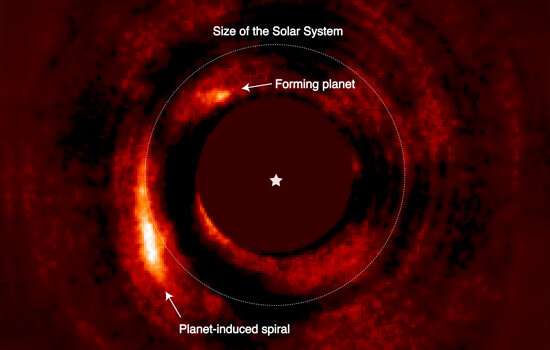This article has been reviewed according to Science X's editorial process and policies. Editors have highlighted the following attributes while ensuring the content's credibility:
fact-checked
peer-reviewed publication
trusted source
proofread
Researchers confirm a new forming planet

A study led by Monash University astronomers published new near-infrared images of the system HD 169142, which enabled the confirmation of a protoplanet forming in the system.
The research team used data from the European Southern Observatory's Very Large Telescope (VLT) in Chile of a star over 350 light years away surrounded by a protoplanetary disk.
"We expect planets to be hot during their formation, and the telescope observed HD 169142 in the near infrared to search for signatures of planet formation around the star," said lead study author Ph.D. candidate Iain Hammond from the Monash University School of Physics and Astronomy.
The images captured with the SPHERE instrument at the VLT reveal a compact source moving over four years (2015-2019). "We successfully detected a protoplanet at approximately 37 au (slightly further than the orbit of Neptune) from the star in all four observations, and it orbits its host star at the expected velocity defined by Kepler's third law."
"This represents a confirmation of previous observations published in Gratton et al. (2019) that claimed a tentative detection of a protoplanet." The new study confirms this hypothesis through both a re-analysis of the data used in their work as well as the inclusion of new observations of better quality.
Only two other exoplanets have been imaged during formation: PDS 70 b and c, which both orbit the star PDS 70. This latest discovery of HD 169142 b pushes that number up to three.
The researchers also found the planet had carved a gap in the disk (the ring-like structure) as it attracted material from the disk itself.
"In the near-infrared we can see a spiral arm being excited in the disk by the planet, which strongly suggests other protoplanetary disks that contain similar spirals could host yet-undiscovered planets," Iain said.
The spectrum suggests that a large amount of dust surrounds the planet, which reflects stellar light. This is expected if the planet is buried in a significant amount of dust that it has accreted from the disk.
"This planet also makes for an exciting target for the recently deployed James Webb Space Telescope." The high sensitivity of JWST will enable researchers to detect hot dust surrounding the planet. The material is expected to take the shape of a circumplanetary disk (a disk around the planet itself) which could form small satellites such as moons. This new detection has proved it is possible to directly image such forming planets even when still completely buried in dust.
The latest study is published in the Monthly Notices of the Royal Astronomical Society (MNRAS).
More information: H Garg et al, A kinematic excess in the annular gap and gas-depleted cavity in the disc around HD 169142, Monthly Notices of the Royal Astronomical Society (2022). DOI: 10.1093/mnras/stac3039
Journal information: Monthly Notices of the Royal Astronomical Society
Provided by Monash University


















